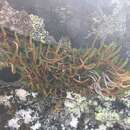Comments
provided by eFloras
Selaginella sibirica is most closely allied to S . rupestris . In addition to differences noted in the descriptions, it can be distinguished from S . rupestris by the numerous marginal cilia on the leaves and by the transparent sporophyll margins; S . rupestris has a variable number (usually few) of marginal cilia and nontransparent sporophyll margins.
- license
- cc-by-nc-sa-3.0
- copyright
- Missouri Botanical Garden, 4344 Shaw Boulevard, St. Louis, MO, 63110 USA
Description
provided by eFloras
Plants on rock or terrestrial, forming discrete long-spreading mats or seldom cushionlike mats. Stems radially symmetric, creeping or decumbent, not readily fragmenting, irregularly forked, without budlike arrested branches, tips straight; main stem indeterminate, lateral branches conspicuously or inconspicuously determinate, often strongly ascending, 1--3-forked. Rhizophores borne on upperside of stems, throughout stem length, 0.2--0.37 mm diam. Leaves monomorphic, in alternate pseudowhorls of 5, tightly appressed, ascending, green, linear-lanceolate to narrowly lanceolate, 2--3.5 X 0.35--0.5 mm (smaller on lateral branches); abaxial ridges prominent; base cuneate and decurrent to rounded and adnate on young lateral branches or buds, glabrous or sometimes pubescent; margins long-ciliate, cilia transparent, spreading to ascending, 0.07--0.17 mm; apex keeled, truncate in profile, obtuse to attenuate; bristle white to whitish or transparent, puberulent, 0.45--0.8 mm. Strobili solitary, 0.5--2.5 cm; sporophylls deltate-ovate to ovate-lanceolate, abaxial ridges well defined, base glabrous, margins ciliate, apex truncate in profile, bristled. 2 n = 18.
- license
- cc-by-nc-sa-3.0
- copyright
- Missouri Botanical Garden, 4344 Shaw Boulevard, St. Louis, MO, 63110 USA
Distribution
provided by eFloras
N.W.T., Yukon; Alaska; Asia in Japan and the former Soviet republics.
- license
- cc-by-nc-sa-3.0
- copyright
- Missouri Botanical Garden, 4344 Shaw Boulevard, St. Louis, MO, 63110 USA
Habitat
provided by eFloras
Dry, alpine, rocky slopes, rock crevices, granite rock, limestone boulders, sandstone, bare open grassy tundra; 130--2400m.
- license
- cc-by-nc-sa-3.0
- copyright
- Missouri Botanical Garden, 4344 Shaw Boulevard, St. Louis, MO, 63110 USA
Synonym
provided by eFloras
Selaginella rupestris (Linnaeus) Spring forma sibirica J. Milde, Fil. Eur., 262. 1867
- license
- cc-by-nc-sa-3.0
- copyright
- Missouri Botanical Garden, 4344 Shaw Boulevard, St. Louis, MO, 63110 USA
Selaginella sibirica: Brief Summary
provided by wikipedia EN
Selaginella sibirica, the Siberian spikemoss, is a species of spikemoss that can be found in dry or exposed rocks and ridges from Alaska to the northwestern region of the district of Mackenzie as well as in northern Russia. The linear leaves are grooved on the back, 2.5-3 millimeters long, including the seta, and usually truncate near the top. Sporophylls are ovate to triangular, and are shorter than the leaves. It looks similar to S. densa, though it can be distinguished by its white setae, compared to the yellow setae of S. densa. Although all discovered specimens in North America are all similar, R.M. Tryon found a phase in Asia that has longer setae that are orange-brown rather than white.
- license
- cc-by-sa-3.0
- copyright
- Wikipedia authors and editors

